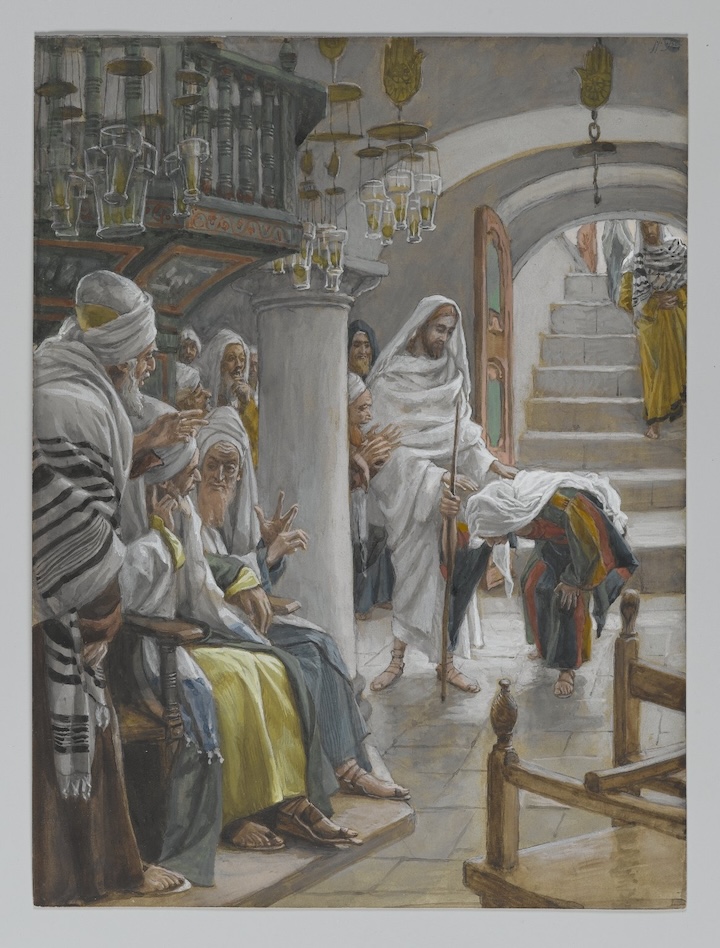Jesus performed many healings on the Sabbath. Doing so caused consternation and condemnation from the Pharisees, for no work was to be done on the Sabbath. Once, when teaching in a synagogue on the Sabbath, Jesus healed a woman who, for eighteen years, was fully bent over. Whereupon “the ruler of the synagogue, indignant because Jesus had healed on the Sabbath, said to the people, ‘There are six days on which work ought to be done; come on those days and be healed, and not on the Sabbath day.’” (Luke 13:10-14)
The synagogue leader is correct. There are six other days on which Jesus could heal people, and so people should come to Him on those days to be healed – and so keep sacred the Sabbath rest. After all, when promulgating the Ten Commandments, God reminded Moses: “Remember the Sabbath day, to keep it holy. Six days you shall labor and do all your work; but the seventh day is a Sabbath to the Lord your God.”
Such a Sabbath rest is in keeping with God’s own example. In six days, God created all that came to be, in heaven and on earth, “and rested on the seventh day; therefore, the Lord blessed the Sabbath day and hallowed it.” (Exodus 8-11) If such is the case, why did Jesus heal on the Sabbath?
Obviously, Jesus knew exactly why – and why, in so doing, He was not breaking the Third Commandment, even if He seemed to be doing so. To discern the full meaning of Jeus’ Sabbath healings, two preliminary points must be kept in mind.
First, Genesis states that having completed his work of creation, “God saw everything that he had made, and behold, it was very good.” (Genesis 1:31) Second, because Adam and Eve sinned, God’s creation was now marred by sin and contaminated with death. In that respect, it was no longer “very good.”
What was God to do? Was He to allow sin and death to have the final word? That would not become the all-good God. God must do something. He must shake off his Sabbath rest and rise up.
In so doing, He begins His new work – the work of re-creation. The entire Old Testament history is the narration of God’s preparation for the re-creation of His sin-marred creation and, particularly, the healing and the re-creation of death-cursed humanity. This salvific preparation finds its culmination in the Father sending his Son into the world.
As God first created everything good through his Word, so God now re-creates everything good through His incarnate Word. Jesus, as the Father’s Spirit-filled incarnate Son, enacts the Father’s work of re-creation. Jesus is the ultimate manifestation that the Father is no longer taking His Sabbath rest, for it is through Him that the Father makes all things new.
Jesus’ healings on the Sabbath signified the re-creating work that the Father had given Him to do. He was overcoming the effects of sin – sickness and death. Jesus’ healings, therefore, prophetically anticipated the ultimate healing of sin and death.

On the Cross, Jesus lovingly offered Himself as the perfect sacrifice to the Father, thus achieving the forgiveness of sin. So pleased was the Father that He gloriously raised Jesus, His beloved Son, from the dead.
On Good Friday, Jesus put the old sin-marred creation to death. Having completed this work, He, on Saturday, took his Sabbath rest. On Sunday, by the power of the Holy Spirit, the Father raised Him gloriously from the dead, and thus obtained His everlasting Sabbath rest.
The risen Jesus literally embodies the new creation. He is the new creation, prefigured and signified in His Sabbath healings. Moreover, on Pentecost, the risen Lord Jesus poured out his Holy Spirit upon the Apostles, and so gave birth to the Church, which baptizes in the Holy Spirit.
Through baptism, we die with Christ. Our sin-marred nature inherited from Adam is put to death, and rises as a new creation in Christ, sharing in his risen and glorified humanity through the indwelling of the Holy Spirit.
As St. Paul declares: “Therefore, if anyone is in Christ, he is a new creation; the old has passed away, behold, the new has come.” (2 Corinthians 5:17) Baptism is, then, the Sabbath day miracle wherein Christians are healed of sin and death and recreated into the likeness of Christ.
Significantly, baptism is administered during the Easter Vigil liturgy and normally on Sundays, both of which are Sabbath days. Moreover, through baptism, Christians enter God’s Sabbath rest, for they share in the everlasting rest of the risen Jesus.
The author of the Letter to the Hebrews is aware of this new abiding rest. He states that, because of their rebellion and disbelief, the Jewish nation failed to enter God’s rest, that is, the land of promise. Even those whom Joshua led into the promised land did not find the fullness of a Sabbath rest, for God spoke of a later Sabbath rest “for the people of God.” “Let us, therefore, strive to enter that rest.” (Hebrews 4:9-11) The further rest of which Hebrews speaks is the heavenly Sabbath rest where one shares fully in Jesus’ everlasting Sabbath rest.
While all Christians enter Jesus’ Sabbath rest through baptism, Catholics enter more fully into that Sabbath rest in the Eucharist, for they partake of Jesus’s risen body and risen blood, and so abide with Jesus. The Eucharist is an earthly anticipation, an earthly foretaste, of the everlasting abiding in the risen Jesus, and so is a sharing in His unending Sabbath rest.
In one of his heavenly visions, John declares what he heard: “I heard a voice from heaven saying, ‘Write this” Blessed are the dead who from now on die in the Lord.’ ‘Blessed indeed,’ says the Spirit ‘that they may rest from their labors, for their deeds follow them.’” (Revelation 14:13)
The Sabbath works that Christians do in Christ on earth merit the everlasting Sabbath rest in Christ in heaven.















